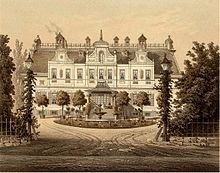Rauschendorf (Sonnenberg)
|
Rauschendorf
Community Sonnenberg
Coordinates: 53 ° 1 ′ 57 ″ N , 13 ° 6 ′ 56 ″ E
|
|
|---|---|
| Height : | 55 m |
| Incorporation : | 1928 |
| Postal code : | 16775 |
Rauschendorf is a district of the municipality of Sonnenberg in the north of Brandenburg . Until 1928 Rauschendorf was an independent manor district .
history
The first written mention as "Ruschendorp" (derived from Ruschen, a type of rush that used to be common in the region) dates back to 1524. The settlement history of Rauschendorf, however, is considerably older. During excavations around 1880, finds from the time of the second century BC were discovered not far from the village - in 1883, Rauschendorf was considered an "interesting and productive site" by archaeologists and ethnologists. However, the finds were not submitted to any scientific analysis, only a Roman fibula from a cremation grave found in 1882 is now kept in the Museum of Prehistory and Early History in Berlin-Charlottenburg.
Further extensive excavations were carried out between 1959 and 1964, which revealed an early imperial urn burial site from the second century BC. The grave goods (pearls, combs, silver locking hooks) are now kept in the Brandenburg State Museum for Prehistory and Early History in Potsdam.
In the 7th or 8th century the location of the Wends . populated. According to the records of Baron von Uslar-Gleichen, Rauschendorf was one of the last retreats of the Wends - they lived there until the 12th century. In the 19th century, Fontane wrote of villages in the Ruppin district where Wendish was still spoken. The horseshoe-shaped arrangement of the houses (Rundlingsdorf) and the adjacent fields, which is typical of Wendish settlements, can still be seen today. The village also found its way into the legendary world of the Wends: "Where the ancients are near Rauschendorf, the grave of the (dwarf) king should also be."
After the Wends were driven out, the Rauschendorfer Feldmark fell to Gebhard von Arnstein in 1220 . He had a knight's seat set up there to secure his property. Until 1524 the field mark Rauschendorf belonged to the Counts of Lindow-Ruppin , a branch line of the Counts of Arnstein . With the death of Count Wichmann I. von Lindow, this family died out in 1524 and Rauschendorf came into the possession of Elector Joachim I of Brandenburg. At this point the village was desolate. In 1528 the elector set up a feudal mayor, whose tasks included repopulating the village, measuring the field markings and allocating the fields. Presumably, the knight's seat ( permanent house ) at the site of today's castle was also uninhabited, but was continued in the knighthood registers to maintain the rights.
The von der Groeben family took over the Lehnschulzenhof in 1552 . In 1581 the family received further lands in Rauschendorf and the surrounding area by way of exchange. In 1687 the knight's seat was again listed as inhabited. After his marriage in 1722 to one of the heiress of the von der Groeben family, the old knight's seat was demolished by Herrmann Graf von Wartensleben and in 1723 Rauschendorf Castle was built using old foundation walls . A previously existing church was not rebuilt in the course of the reconstruction of the village around 1700, as the patronage church of the von der Groeben / von Wartensleben families was in Meseberg. Rauschendorf was therefore a parish in Schönermark (also owned by the Count of Wartensleben). In 1799 the village had 15 male, 13 female residents, 39 children and 15 servants (a sign of the extent of the court holding of the castle, which at that time was owned by Count Blumenthal). In the following time until 1945 the place developed as a typical manor village. In 1928 the manor district was merged with the community of Sonnenberg under the name of Sonnenberg. In 1945 the property was divided. In 1952 the first agricultural production cooperative was founded in what was then the Gransee district with the name " Karl Marx ", which was transferred to Agrar GmbH Sonnenberg in 1991/1992. In 2009 the old village pond was restored in the center.
Population development
| date | Residents |
|---|---|
| 1766 | 72 |
| 1785 | 74 |
| 1800 | 99 |
| 1817 | 97 |
| 1840 | 117 |
| 1858 | 162 |
| 1895 | 184 |
| 1925 | 231 |
| 1980 | 247 |
| 2016 | 153 |
Culture and sights
In addition to the manor house Schloss Rauschendorf, there are two avenues worth seeing, which are now registered as natural monuments: the linden avenue, which leads into the village and is one of the last closed avenues in Brandenburg, and the chestnut avenue to Wolfsruh. Furthermore, some of the residential buildings in the village center, which formerly belonged to the estate, have now been restored in accordance with listed buildings.
Web links
Individual evidence
- ^ Yearbook of the Ethnological Society, Berlin 1883.
- ↑ H. Geisler: The early imperial burial ground near Rauschendorf, in: 25 years of archaeological research in the GDR, volume 21.
- ^ Theodor Fontane: Walks through the Mark Brandenburg.
- ^ Willibald von Schulenburg: The Wendish folklore in legend, custom and custom. Leipzig 1888.
- ↑ Codex Diplomaticus Brandenburg
- ↑ a b c d Bratring: The county of Ruppin. Berlin 1799
- ↑ residents as of December 31, 2016. In: gransee.de. Retrieved January 20, 2018 .
- ↑ Lieselott Enders : Historical local dictionary for Brandenburg . Part 2 Ruppin. Potsdam 2011.
